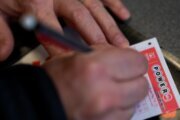This article was republished with permission from WTOP’s news partners at Maryland Matters. Sign up for Maryland Matters’ free email subscription today.
This content was republished with permission from WTOP’s news partners at Maryland Matters. Sign up for Maryland Matters’ free email subscription today.
More than 90% of students, faculty and staff at most of Maryland’s colleges have complied with COVID-19 vaccine mandates this fall semester, but the state’s historically black colleges and universities are lagging behind.
The majority of the University of Maryland System’s 12 institutions have vaccination rates of 94% to 98%, Joann Boughman, senior vice chancellor for academic and student affairs for USM, told lawmakers at a briefing on higher education Thursday afternoon.
All students and faculty at St. Mary’s College of Maryland, which is not part of the university system, are vaccinated after 15 students who did not get vaccines were disenrolled, said Charles Jackson, government relations liaison for the college.
The University of Maryland College Park has a vaccination compliance rate of 97.7%, which means that fewer than 300 out of over 39,000 students are not vaccinated, Boughman said. But a large portion of unvaccinated students are international and are currently in the vaccination process, she continued.
By contrast, historically black colleges and universities within the University System of Maryland — Bowie State University, Coppin State University and University of Maryland Eastern Shore — have vaccination rates between the “very high 60s” and 86%.
“But this isn’t unexpected for us,” Boughman said. “We know there is not only vaccine hesitancy in some of our populations and communities, but real challenges in terms of access for some people over the summer.” The three HBCUs are working hard on promoting vaccination and have on-campus vaccination clinics, she continued.
Regardless of vaccination status, however, all of USM’s 12 institutions have a universal indoor masking policy, according to Boughman.
There are also low numbers of positive COVID-19 cases across USM institutions. Out of 3,221 tests that Salisbury University conducted last week, there were only 19 positive cases, according to Boughman. Similarly, the University of Maryland College Park carried out almost 2,500 COVID-19 tests and had only nine positive cases. USM is requiring rapid and frequent COVID-19 testing for the unvaccinated, she continued.
However, Del. Jared Solomon (D-Montgomery), vice chair of the Education and Economic Development Subcommittee, took issue with the fact that implementation was left to each campus, even though USM mandated COVID-19 vaccination across all of its institutions for the fall semester.
“Many of us were surprised to see that despite the system’s policy, the method to carry that out was really being left up to individual campuses…it’s widely varied,” Solomon said. “We want to protect the faculty, we want to protect the staff, we want to protect other students at every school, and I don’t really understand the discrepancy.”
For instance, students at Bowie State University have until Sept. 30 to get fully vaccinated while Towson University students have to provide proof of their first dose of the COVID-19 vaccine by Sept. 10 and University of Maryland College Park’s deadline was Aug. 16.
And while University of Maryland College Park and University of Maryland Baltimore reported that they will place a registration hold for unvaccinated students, others — Towson University, Bowie State University, Salisbury University and University of Maryland Eastern Shore — reported that they will not, according to a spreadsheet created by USM at the request of lawmakers for Thursday’s meeting.
Unvaccinated students who do not have a vaccine exemption at Frostburg State University, UMBC and Bowie State University are barred from entering campus, but unvaccinated students who do not have a vaccine exemption at Salisbury University are only subject to frequent COVID-19 testing, according to university officials.
Boughman said flexibility was necessary because the system’s 12 institutions are “very different.” For instance, the University of Baltimore has no residential buildings and almost all of their undergraduates are attending classes virtually, while other institutions have large residential and dining spaces, she continued.
A representative from the American Federation of State, County and Municipal Employees Council 3, the largest state employee union, said its members have also been wrangling with the lack of a system-wide coordination among USM institutions, specifically on safe working condition policies.
For example, the University of Maryland College Park is not offering COVID leave with pay for its staff, so if an employee has to quarantine and does not have any more days of personal leave left, then it becomes leave without pay, said Celina Sargusingh, an employee at UMD College Park and executive board member of AFSCME Local 1072. The union has also been asking for a universal telework policy for all employees at USM institutions, especially while the coronavirus remains a threat.
“Many campuses are not on the same page and are not approaching [employee health and safety policy] in a unified manner, and that’s disturbing,” said Patrick Moran, the president of AFSCME Council 3. “It’s unsafe and it’s unhealthy, for not just the employees but for the students as well.”
This year, Gov. Lawrence J. Hogan Jr. (R) vetoed a bill that would have required the chancellor of the University System of Maryland to act on behalf of all the system’s institutions in all aspects of collective bargaining, consolidating the process at the top. Moran pushed lawmakers to override the governor’s veto in the next legislative session.
Union members at Thursday’s meeting also implored USM to institute a minimum wage of $15 an hour. However, Moran stressed that even that standard equates to only $31,200 a year. “I challenge anyone to try to live on $31,200 a year in one of the wealthiest — if not the wealthiest — states in our country,” Moran said.
EDITOR’S NOTE: Incorrect information about the University of Maryland Baltimore County’s COVID policies was shared at the Sept. 9 legislative briefing. This article has been updated to correctly reflect the university’s policies.







